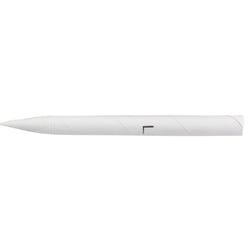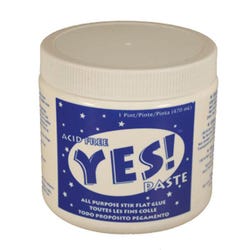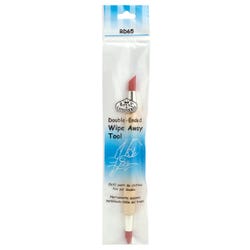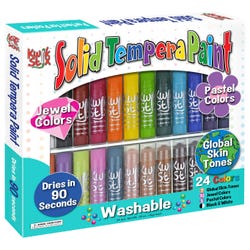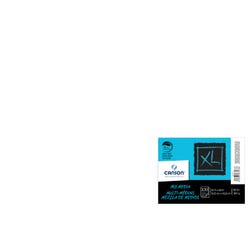Nature Is a Painter

Description
Lesson Plan and Artwork by Phyllis M. Annett
Direct students to create an autumn landscape ablaze with color using Tempera Paint Kwik Stix® Global and Primary colors. The inspiration for this lesson comes from the Fauvism movement because of the bright colors, strange shapes, and emotional brush strokes. This lesson will focus on Arborology sketches, art history, painting techniques, and experimental finds, all appropriate for Kwix Stix use!
Objectives
- Understand the unique characteristics of Kwik Stix Tempera Sticks and apply techniques and processes.
- Learn about Arborology, the study of the life cycle and needs of trees.
- Recognize the value of Art and Art History, and realize how they can be a continual source of learning.
Supplies Needed
Kwik Stix™ Multicolor & Global Set, Set of 24
Non-Toxic Water Based Glue, 16 oz Jar
Royal & Langnickel® Wipe Out Tool, Dual Ended, Set of 2
Single-Pointed End Large Blending Tortillons, Pack of 12
Canson® XL Mixed Media Paper, 98 lb, 12 x 18", 100 Sheets
*Here are the supplies needed for this lesson plan for reference. Find a convenient carousel of shoppable products for this lesson below.
Standards
Standard #2: Organize and develop artistic ideas and work.
Standard #3: Refine and complete artistic work.
Standard #6: Convey meaning through the presentation of artistic work.
Instructions
1
Inform students that they will be painting a landscape in the style of the Fauves from the early part of the 20th century, using Kwik Stix tempera paint in stick form.
2
Fauvism history for inspiration: Provide students with examples of the Fauve art movement and its artists Georges Braque, Henri Matisse, Georges Rouault, Andre Derain, Albert Marquet and Kees van Dogen. These artists were called Fauves (Wild Beasts) because they used bright, bold, pure color with short energetic marks and lines to portray the brilliance of light on bold hues. Their use of great sweeping strokes of color, showing emotion, energy, movement, balance, proportion and patterns, produced works that hovered between reality and abstraction.
3
The Fauves focused on color and sometimes distorted the perspective of their landscapes. Fauvism was spontaneous and quite different from what the world knew of art at that time. The works of Derain and Matisse, who were great friends, produced wonderful arbitrary colors for their landscapes rather than those from nature itself. The Fauvism Movement lasted from 1904 to 1910. It was the first avant-garde art movement of the 20th century and turned the world of art upside down. It broke away from Impressionism and older traditional types of art.
4
Set time aside for students to sketch general shapes of trees. Information can be found in Arborology books on line, or from the great outdoors! Use the sketches as a reference tool to develop the trees in the landscapes.
5
Students will discover that Kwik Stix do not require water or brushes. They are available in three sizes and are a chubby stick form, ready to paint. They are “nomess,” washable, non-toxic, rated AP, and free of nuts, eggs, oil, soy, and dairy. They come in a choice of colors including Classic, Neon, Metallic, and Global. They’re easy to use on paper, wood, plastic, eggs, windows, mirrors, posters, and rocks—just uncap, twist, and paint. Note that they dry in 90 seconds, so work a bit faster than usual!
6
Art Educators will demonstrate techniques from Kwik Stix on paper. Students will experiment with Kwik Stix and develop both color and technique charts to use as references for their Fauve-like autumn landscapes. Kwik Stix are good for layering color over color, although the bottom layers must be dry before applying the next layer. After all layers are on and dry, use a stylus stick or wipe away tool to incise marks to reveal colors from each layer (this is the Sgraffito technique). Also use any of these Kwik Stix techniques—stippling, layering, blending, wet on wet, underpainting, stenciling, mixing of color on palette and on the canvas, gradient plains, sgraffito, blending, and surface finishes—to add more interest and protect the work.
7
Develop a balanced composition citing the elements and principles of art. Encourage students to study images of good composition from Henri Matisse, Andre Derain, and Paul Singac of the Fauve Movement. Students will decide upon a specific composition and keep a sketch of it for reference.
8
Remind students to work from background to middle, then to foreground. The landscape is to have a forest of trees in autumn colors. Remind them to recall how the Fauves loved to use expressive color and line to build their landscapes. Don’t get too involved with detail. Color is really the main subject of the lesson.
9
Have students start to paint by blocking in light and darks with a soft color. Next, instruct them to block in the background (sky color). Work on the sky. Are there clouds? Question students: Will they follow the Fauves and put in odd colors for the atmosphere? Does their work hover between reality and abstraction as the Fauves portrayed? Are mountains laden with energetic trees, shapes, and twisting roads? Are there fences and animals, etc.? Students’ imaginations will show through their work. Have students implement techniques learned in step 6 to complete work.
10
Optional: As a final step, spray the artwork with a clear or gloss finishing spray to extend its life.
11
Critique all work with students. Display all work and be proud of your students!



